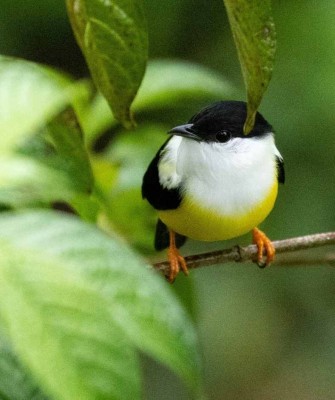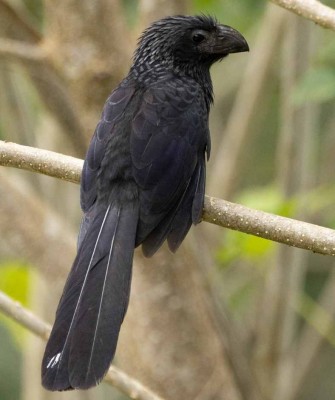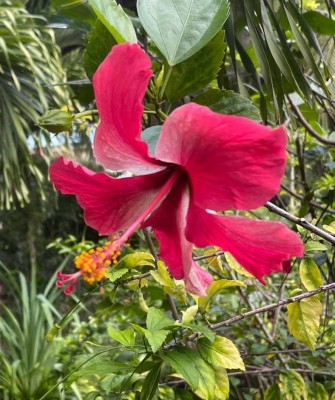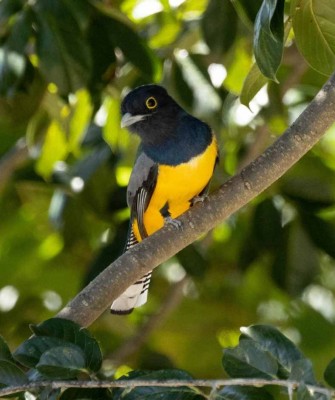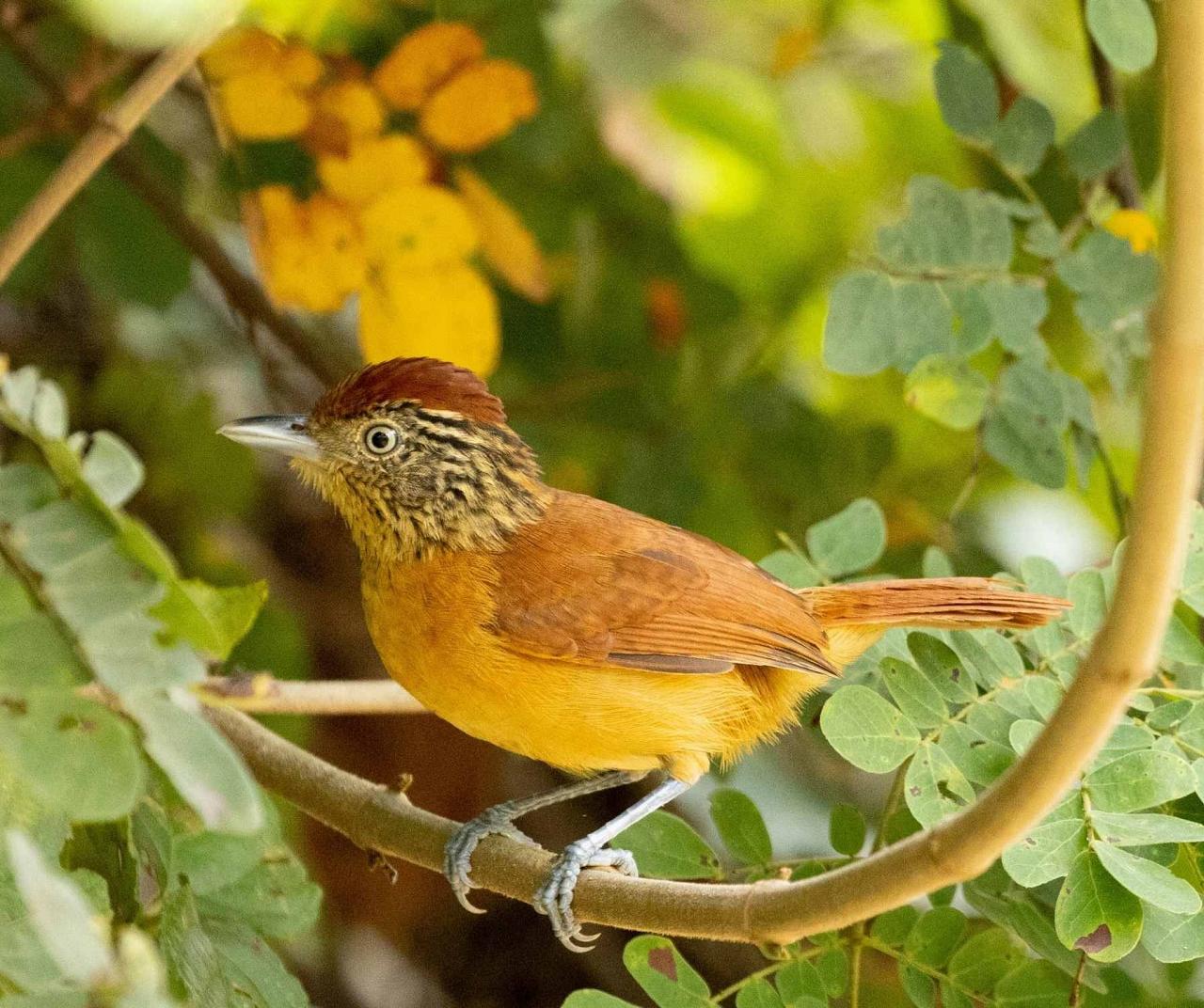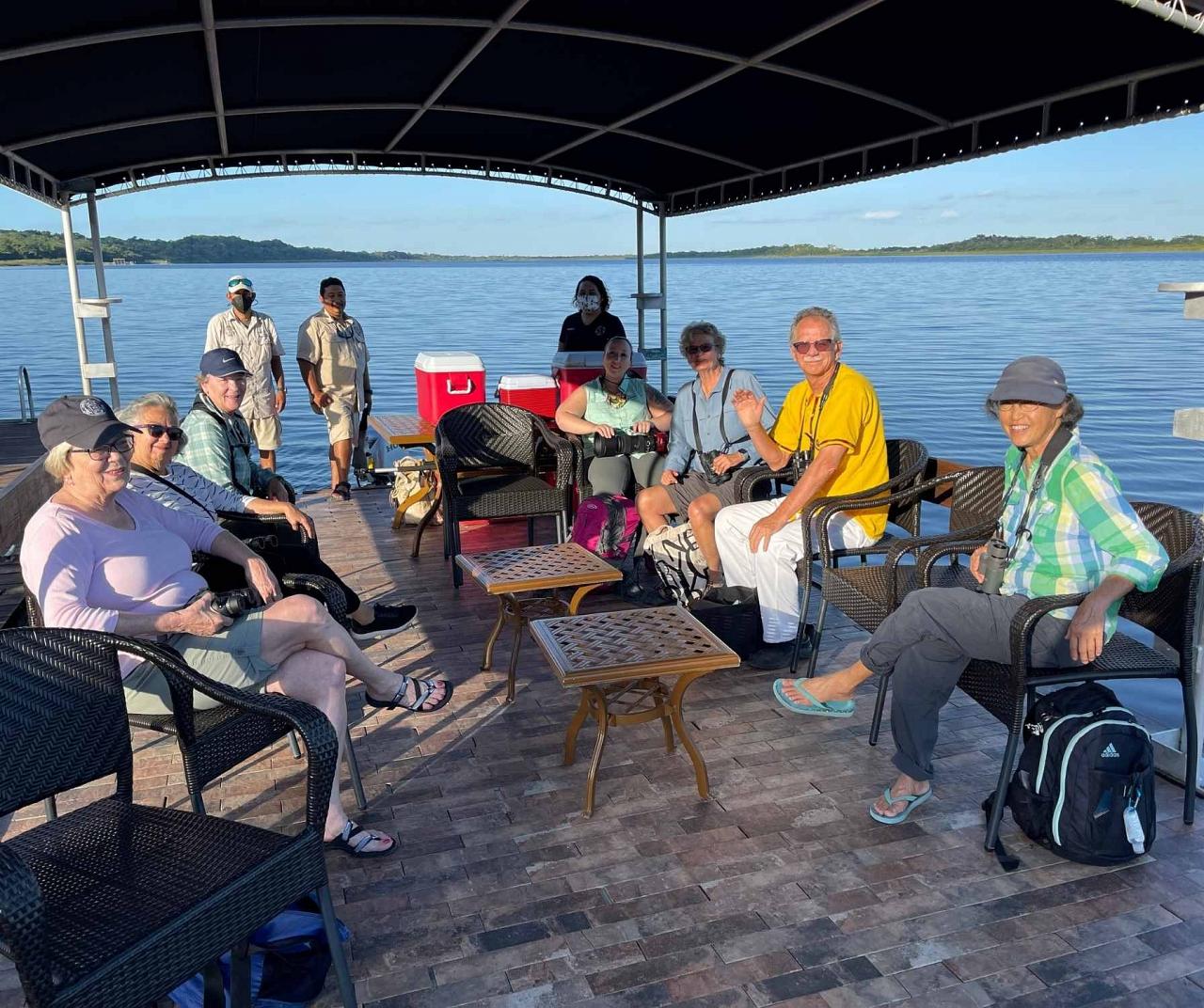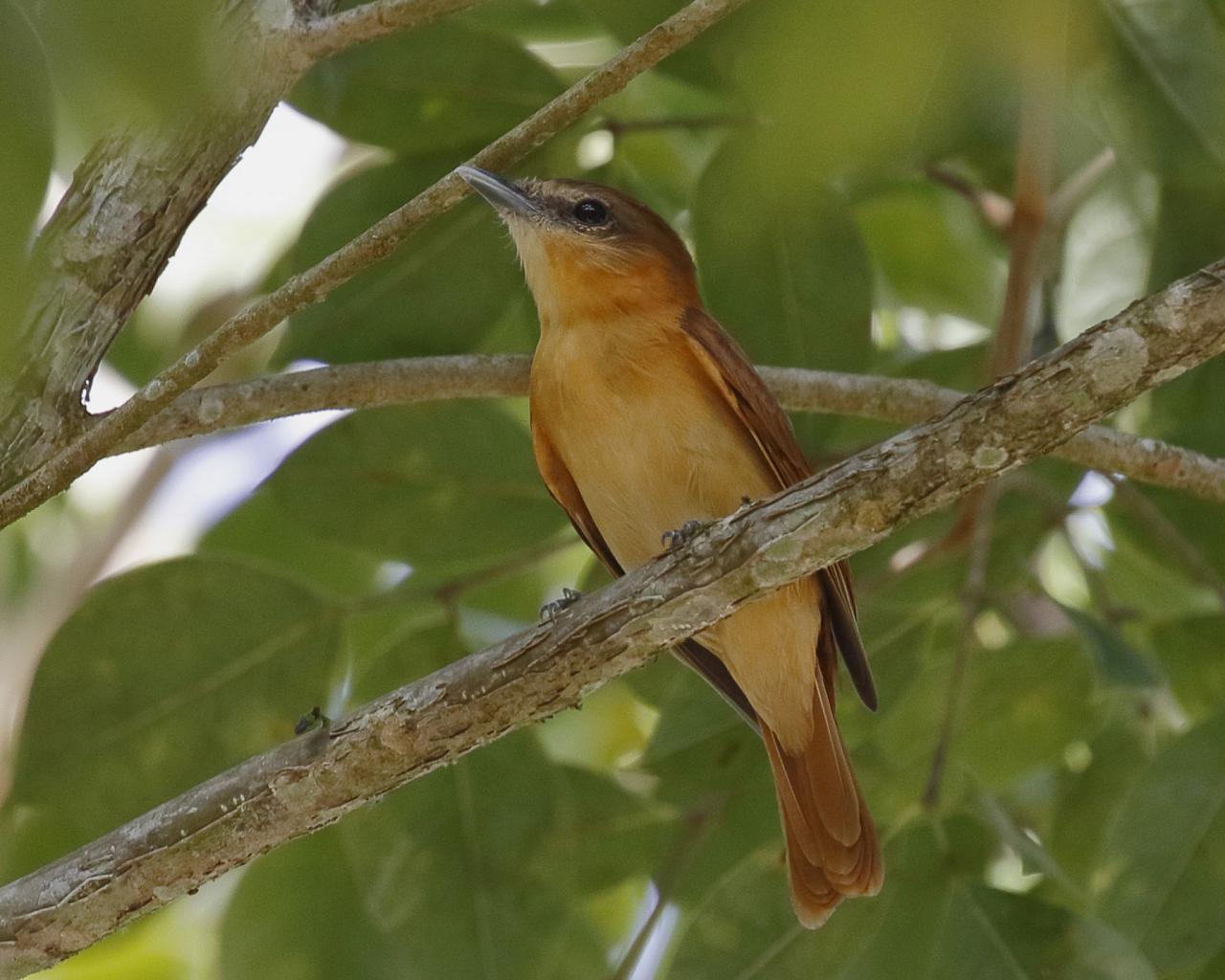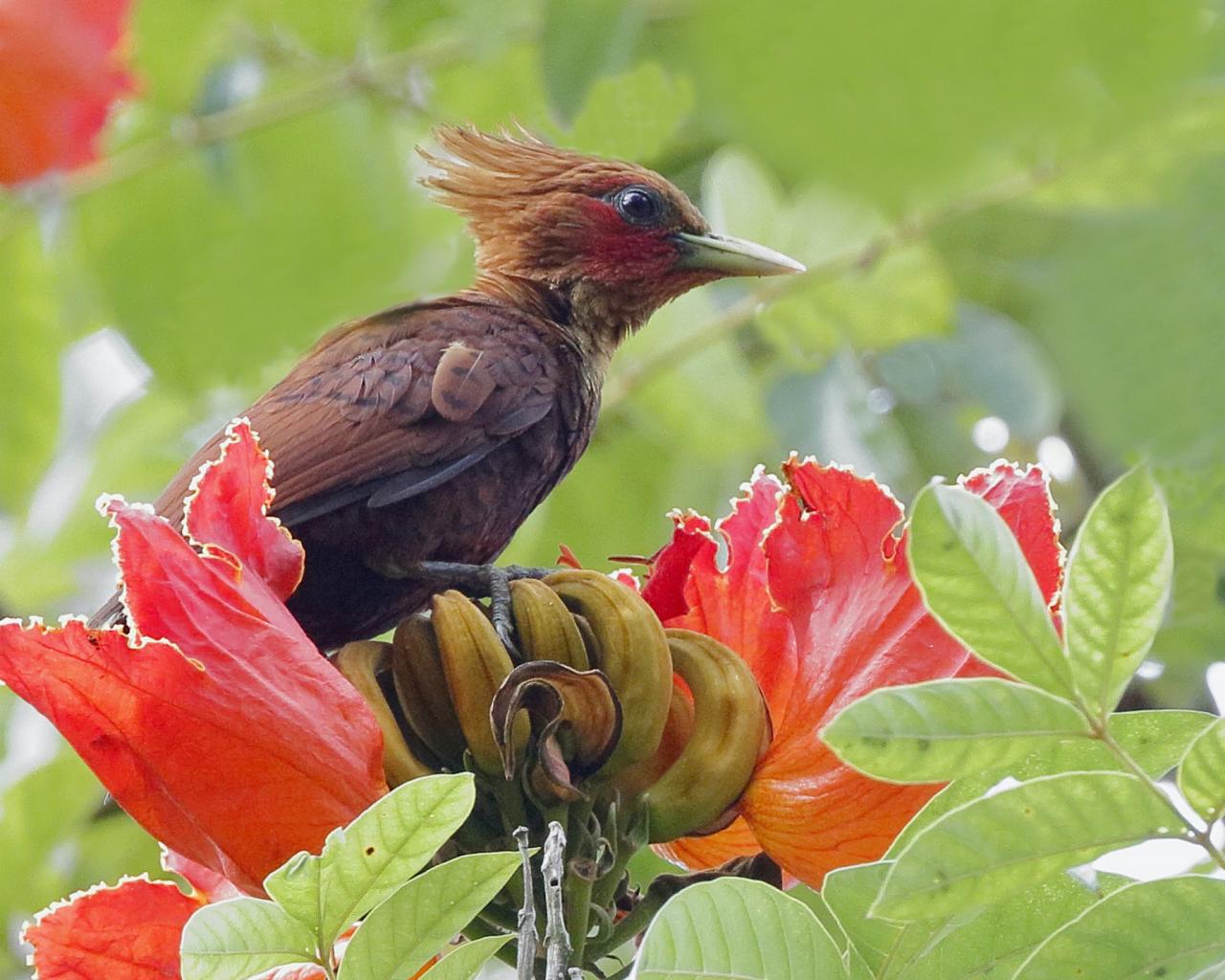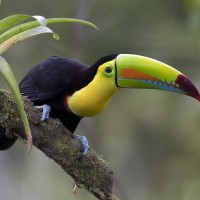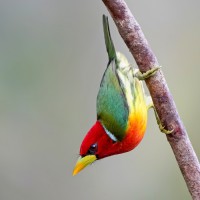Trip Itinerary
Itineraries are guidelines; variations in itinerary may occur to account for weather, road conditions, closures, etc. and to maximize your experience.
Sun., Dec. 21 Welcome to Belize | Lamanai Outpost Lodge
Fee that warm and welcoming tropical air as you emerge from the plane in Belize … you have arrived and the birds are waiting! We head from the Lamanai office (very close to the airport) to their dock on the New River Lagoon, and soon we are on the boat and bound for Lamanai Outpost Lodge, our home for the next three nights. The transfer into Lamanai is FUN. From the boat, we should see Mangrove Swallow, Limpkin, Northern Jacana, Swallow-tailed and Snail Kites, and, with luck, a Black-collared Hawk or a huge Jabiru. Be ready with a windbreaker, camera, and binoculars. Just before reaching the lodge we pass by the famous Lamanai Archeological Site, which we can explore from our lodge. We arrive in time to settle into our casitas and enjoy dinner with an open-air river view.
Accommodations at Lamanai Outpost Lodge (D)
Mon., Dec. 22 Lamanai Outpost Lodge
Whether you’re well-traveled in Central America or visiting for the first time, there is much to hold your attention at Lamanai. Birds and monkeys busy themselves around the cabins; nearly 200 species of butterflies flit through the area, colorful dragonflies and damselflies buzz by, lizards ranging in size from tiny geckoes to five-foot-long iguanas lounge around, and of course, numerous herbs, shrubs, and trees attract wild tropical wonder.
During our stay we take several boat trips. Canoe excursions offer relaxing and intimate wildlife views, and can be arranged for both day and night paddles. Such trips frequently produce an endangered Morelet's Crocodile, iguanas, and basilisk lizards, up to five species of kingfishers, Boat-billed Heron, Gray-necked Wood-Rail, and occasionally a rarity like an Agami Heron. At night, with the aid of spotlights, we look for several species of bats, Yucatan Nightjar, Yucatan Poorwill, and Northern Potoo.
We also make sure to have time to see the impressive Lamanai Maya Ruins, and to explore the open savanna habitat, which affords us a good mix of species including Yucatan Woodpecker, Yellow-lored Parrot, the Petén race of Botteri’s Sparrow, and occasionally Aplomado Falcon.
Accommodations at Lamanai Outpost Lodge (B,L,D)
Tues., Dec. 23 Lamanai Outpost Lodge
Lamanai is situated right on a wide stretch of the New River and birds at the water’s edge become familiar: Neotropic Cormorant, Yellow-crowned Night-Heron, and Purple Gallinule. Others, like White-collared Seedeater, Mangrove Vireo, Ruddy Crake, or the delightful American Pygmy Kingfisher remind you that you have left the United States.
Open-air dining lets you be immersed in nature; local foods and tropical fruits abound! One of our lunches is hosted by the local village, which is home to several of the lodge guides. A loop walk around the village lets us enjoy sightings of many open country species including close up views of toucans.
One of the most interesting phenomena, and one we are likely to encounter at Lamanai on forest trails, is an army ant march. Birds of many families attend these marches, eating the insects, frogs, lizards, and other organisms flushed by the foraging ants. Standing quietly at the margin of an ant swarm, we get close looks at faithful ant followers, including Gray-headed Tanager, Red-throated Ant-Tanager, and a number of woodcreepers, including Tawny-winged and Northern Barred. Other possibilities are White-whiskered Puffbird, several flycatchers, migrant warblers, and perhaps a Great Tinamou. Even birds of prey like the dainty Barred Forest-Falcon follow ant swarms?all so absorbed in the sea of insect life that they ignore our fascinated observation.
Time at this delightful lodge passes all too quickly! Savor highlights of the trip so far over dinner and tally up the day’s sightings with your guides.
Accommodations at Lamanai Lodge (B,L,D)
Wed., Dec. 24 Lamanai Outpost Lodge to Tanager Rainforest Lodge by Air
We leave Lamanai Outpost Lodge after an early breakfast, taking the fast boat back to the dock. It is about an hour from here back to the airport, where we board our scheduled flight to the southern part of the country. We are met at the airport in Punta Gorda, a lovely small beach community. We check the waterfront for Laughing Gull and possible seabirds, then head to Tanager Rainforest Lodge. We settle in to our cabins, and meet up to bird the lodge property, which sits on thirty acres on a long meander of the Rio Grande and includes riparian, secondary growth forest, disused agricultural land, orchard, and meadow habitats. Species we search for include Black-faced Antthrush, Barred Antshrike, Great Antshrike, Bare-crowned Antbird, Black-and-white Owl, Crimson-collared Tanager, Golden-hooded Tanager, Black-crowned Tityra, Pale-billed Woodpecker, Lineated Woodpecker, and Stub-tailed Spadebill.
We know you’ll enjoy being at delightful Tanager Rainforest Lodge. In the afternoon, we can meet up for drinks and sunset birding on the deck before a great dinner together, artfully prepared.
Accommodations at Tanager Rainforest Lodge (B,L,D)
Thurs., Dec. 25 Christmas at Tanager Rainforest Lodge
Merry Christmas! Today is gentle, with lodge and possibly local birding opportunities, as well as time to just relax in nature. With such excellent birding right on our doorstep, it’s hard to resist getting up at the crack of dawn, soaking in all the morning bird song with coffee or tea in hand. Off-site excursions may be available, but we leave today loose to keep things relaxed and to enjoy the holiday. Tonight enjoy a special dinner at the lodge and hear about plans for tomorrow’s adventures.
Accommodations at Tanager Rainforest Lodge (B,L,D)
Fri., Dec. 26 Nim Li Punit Maya Ruin at Dawn | Local Hills & Hotspots
After grabbing coffee, juice, and a roll, our early morning birding outing today with Steven Choco focuses on the Nim Li Punit Maya site, located just six miles from the lodge. Nim Li Punit, which is Kekchi Mayan for “Big Hat,” dates from the Maya Classic Period that flourished from the 5th through the 8th Century AD, and consists of three distinct plazas and several step-pyramids. In 2015, the second largest carved jade artifact in Belize was discovered here. The site itself is set high in mature forest with fantastic views east across the coastal plain to the cays in the Gulf of Honduras.
The area offers some very good birding, including several woodpeckers (Lineated, Pale-billed, Smoky-brown, and potentially Chestnut-colored) and woodcreepers (Streak-headed, Wedge-billed, and Ivory-billed), as well as various migrant warblers and vireos. Other possible highlights include White-crowned Parrot, Keel-billed Toucan, White-throated Thrush, Hook-billed Kite, Red-legged and Green Honeycreeper, Bat Falcon, Yellow-bellied Tyrannulet, Blue Grosbeak, Montezuma Oropendola, and Rose-throated Becard.
We return for a proper breakfast, and then head out for low hills, a karst landscape about 12 miles from the lodge. Our goal is to bird across an orange grove (Belizean orchards are not the manicured settings we’re used to at home, and can be great for birding), and eventually arrive at the karst limestone foothills that rise to a height of around four hundred feet. As the ground slopes upwards, we enter a broadleaf forest. We look for some of the most difficult to locate species in Belize, including Tody Motmot, Rufous Piha, Rufous Mourner, Northern Schiffornis, Nightingale Wren, Scaly-throated Leaftosser, White-winged Becard, Tawny-crowned Greenlet, and Northern Barred Woodcreeper.
As the day heats up, we head to Ixcacao Maya Belizean Chocolate, a small twenty-year old business run by Juan and Abelina Cho. We have lunch here with a chocolate-themed main course and a selection of beautiful vegetable dishes from their own gardens. We also have a chance to try a variety of chocolate flavors such as chocolate with salt, chili, cardamom, ginger, and coconut and learn about the chocolate making process. We return to the lodge for a break—swimming or kayaking, or perhaps a good book and a hammock on your veranda.
We gather on the lodge’s porch this evening to update bird lists and review the day, and after dusk we may get lucky and hear (or even see) one or more of the resident Black-and-white Owl, which previously nested on the lodge grounds. We should also see Common Pauraque and Lesser Nighthawk flitting across the dusky sky before we head inside. Dinners here are excellent, often featuring fresh seafood and Belizean beef, with local fruits and vegetables—a perfect end to the day.
Accommodations at Tanager Rainforest Lodge (B,L,D)
Sat., Dec. 27 Blue Creek or Guide’s Choice | Rice Fields
Steve is such a master birder, and we like to allow him some choices to make the most of the moment. He may choose Blue Creek, a great hike with some primary forest and attendant elusive species; or, we may rise early to leave for birding among mature forest about two miles from the coast at Punta Gorda. The area is home to a troop of Yucatan Black Howler Monkeys that we have a good chance of seeing and hearing in the forest canopy. There are local pocket wetlands where we look for Little Blue Heron, Green Heron, and other egrets as well as roosting Yellow-crowned Night-Heron.
Birding at any site Steve chooses can be excellent, with important species in field and forest edge habitats include Striped Cuckoo, Bronzed and Giant Cowbirds, Plain-breasted Ground Dove, Blue-black Grassquit, Scaly-breasted Hummingbird, Fork-tailed Flycatcher, and Scrub Euphonia. The gorgeous Crimson-collared Tanager and closely related Passerini’s Tanager (the latter a specialty for southern Belize) are also both found along the road into Blue Creek (as well as on the lodge grounds). Less common raptors like Gray-headed and Double-toothed Kites are occasionally seen here, together with the common Roadside Hawk.
Birding mature forests in these areas can yield a number of intriguing mid-canopy and understory species, including Lesson’s Motmot, Little and Great Tinamous, Collared Trogon, White-breasted Wood-Wren, Strong-billed Woodcreeper, Red-capped Manakin, Black-crowned Antshrike, and the seldom seen Ruddy-tailed Flycatcher. Along the forest margins we look for Collared Aracari, as well as White-whiskered Puffbird and Rufous-tailed Jacamar, the latter species typically sitting motionless for extended periods as they wait for large insect prey.
On this, or another day pending our birding site locations, we visit the small town of Big Falls for lunch at Pearleen’s restaurant. This is Caribbean food like you’ve never eaten, almost reason to book the trip! We may visit a local spice farm during the mid-day quiet hours, a fascinating operation with tropical spices grown from around the world.
Before sunset we have the option to visit what is known as the “Dump Rice Field,” an expanse of rice paddies and swamps located a short drive from the lodge. The road passing through sits on an elevated causeway, with side tracks leading into the marshy areas. Key species here include Sora, Ruddy and Uniform Crakes, Purple Gallinule, White-throated Flycatcher, Least Bittern, Short-tailed Hawk, Limpkin, and Common Tody-Flycatcher. We enjoy a final celebratory dinner this evening is at the lodge.
Accommodations at Tanager Rainforest Lodge (B,L,D)
Sun., Dec. 28 Departures
Our adventure comes to an end today. This morning we drive the 30 minutes to Punta Gorda and board a Tropic Air flight back to Belize City. To ensure a smooth connection, please plan your international flight to depart after 1:00 PM today. (B)
Essential Information +
Ahead of your tour:
Make sure your passport will be valid at least three months after Read more
Ahead of your tour:
- Make sure your passport will be valid at least three months after the date of your scheduled return to the U.S. See "Passports, Visas & Documentation" section below for details.
- No Visas are required for U.S. citizens for stays of this length in Belize. If you are from another country, contact your embassy for travel documentation guidance.
- Please check current CDC recommendations for travel to Belize and consult with your doctor about general travel vaccinations you should have as precaution for travel. See the “General Health and Inoculations” section below.
- Travel insurance in case of serious medical emergency is strongly recommended. Full health coverage and repatriation is available through Allianz Travel Insurance.
- Soft sided luggage/duffel bags are easiest for packing the vans. See "Packing List" tab for important packing details and recommendations.
Passports, Visas & Documents
Guidelines and regulations can change. It is always advisable to double-check the country’s documentation requirements 60-90 days ahead of traveling. Information for U.S. citizens can be found at https://travel.state.gov/content/travel/en/international-travel/International-Travel-Country-Information-Pages/Belize.html. If you are from another country, please contact the tour destination’s embassy website for guidelines.
Passport: At the time of writing, U.S. citizens must have a passport that is in good condition and at minimum is valid at the date of entry through your scheduled return to the U.S. However, we highly suggest at least 3 months validity beyond the end of the tour to allow for unexpected delays in return travel. Please check that expiration date! You should have at least one blank page per entry stamp. The blank pages need to say “Visas” at the top. Pages marked “Amendments and Endorsements” will not be accepted.
Visa: At the time of writing, a tourist visa is not required for stays of this tour's duration. You will need proof of a return ticket. We advise that you bring your eContact list of hotels for use at immigration as well.
Travel Tip: As a precaution for lost or misplaced documents you carry on your person during travel, we highly recommend you keep hard and digital backup copies on your phone (either photo or PDF scan), as well as a hard copy left with your emergency contact at home. The recommended important documents to copy include, but are not limited to; your passport ID page, travel visa, the front and back of your credit card(s), the airline barcode on your luggage. This will greatly expedite getting new ones if necessary – we hope everyone will always keep travel documents close so that losing them will not be an issue.
General Health & Inoculations Information - Be Prepared!
Health and vaccine requirements for entry to any country can change at any time. Be sure to double-check the country’s health requirements and recommendations 60-90 days ahead of traveling and consult with your doctor about any personal health concerns regarding the environments you will encounter on your trip. A helpful website for planning is the Centers for Disease Control and Prevention (CDC) website for Belize or by phone (800) CDC-INFO or (800) 232-4636.
We will share your health information with your guide. This information will be kept confidential but is very important as we want to be best prepared in case of medical emergency.
Vaccinations: Please bring your up-to-date vaccination records with you. The CDC recommends that all travelers be up to date with routine vaccines and basic travel vaccines (such as Hepatitis A and Typhoid, etc.). Consult with your doctor for recommendations at least 4- 6 weeks before departing on your trip, as some vaccines may require more than one dose and time to become effective prior to your departure.
Mosquito and tick-borne illness: The CDC will have updated information regarding recent disease outbreaks, such as Malaria or other mosquito or tick-borne diseases, as well as extra precautions to take depending on the area(s) you will be traveling through. Travelers should reduce their risk of mosquito and/or tick-borne diseases by protecting themselves from bites using protective clothing, insect repellant (containing DEET, Picaridin, OLE, etc.) and prophylactics where applicable. Check the CDC and with your doctor to see whether your trip destination is currently at risk for malaria transmission and whether you should consider anti-malarial medication. For repellent permeated clothing, see Packing List for our recommendations. See the “CDC Yellow Book: Health Information for International Travel” website for more information: https://wwwnc.cdc.gov/travel/page/yellowbook-home.
Prescriptions: It is a good idea to pack any meds you take regularly in your carry-on luggage. Bring an extra pair of your prescription glasses or contact lenses. Bring an adequate supply of any prescription medications you use, a copy of the prescription and a list of generic names of your medicines as “back-up” in case it is necessary to purchase drugs while abroad. Your doctor may also recommend some prescription medications to bring with you to treat possible illnesses that might occur, depending on your destination, such as an anti-malarial medication or an antibiotic. You’ll want to keep all medications in their original, labeled containers.
Allergies: To be prepared for environmental triggers to allergies or breathing difficulties, please bring your allergy and/or asthma medication(s). If you have severe allergies talk to your doctor about carrying an EPI pen and notify your guides. It is also recommended to carry with you an up-to-date record of known allergies, chronic medical problems and Medic Alerts so that, if necessary, emergency treatment can be carried out without endangering your health.
Common Ailments: We recommend that you bring a travel-sized first aid kit and a supply of standard over-the-counter medications for prevention or treatment of common ailments (such as diarrhea, constipation, stomach upset, cough, congestion, head or body aches, motion sickness, insect bites and sunburn); as well as ointments, moisturizer, sunscreen, oral rehydration salts, band-aids, moleskin for blisters, cotton swabs, nail clippers, and tweezers, etc.
Altitude illness: If high altitude will be encountered on your trip, it can affect some and, if there is a concern, be prepared. The most general symptoms are headache and occasionally fatigue and dizziness. You’ll want to take it easy, particularly at first. The likelihood of these symptoms can be reduced by resting, drinking plenty of water, avoiding alcohol and taking aspirin. If you have worries about the altitude, ask your physician about medications (such as Diamox) that may be right for you. For more information, see https://www.cdc.gov/yellow-book/hcp/environmental-hazards-risks/high-altitude-travel-and-altitude-illness.html.
Weather & Climate
The climate in Belize is tropical, and in general, the weather during your stay should be humid with warm to hot temperatures (75-90°F) in the lowlands, but can cool off into the high 50°Fs to mid-60°Fs in the early morning and evenings. The hot and rainy season ranges from June-October, while November-February have slightly cooler temperatures (though still warm and tropical!) with tapering rainfall. February-May begin with the dry season, that eases into the hotter and wetter summer months. When the skies are overcast, boat tours can be cool.
You may check your preferred weather app closer to departure to get a better idea of the imminent weather to expect.
Annoyances & Hazards
Always listen carefully to any advice given by your local guide regarding pests and other biting insects or reptiles you may encounter, especially those that may be poisonous, though this may be rare.
Mosquitos, ticks and other insects: Even if you are traveling in the dry season, mosquitos, ticks and other insects can always be encountered in your travels, so don't risk illness. See the “General Health and Inoculations” section above regarding recommended preventative measures.
Chiggers are a part of lowland and mid-elevation habitats. You may encounter them at grassland or farm locations. Your guide should have a good read on whether chiggers are a concern. It is helpful to spray your shoes with repellent and tuck your pants into your socks . When back, be sure to shower and air out your clothing.
Remember, sunburn can be both an annoyance and a hazard, so be prepared with sufficient sun protection.
Food & Drinks
Menus at lodges and restaurants are varied, sustainably based on the wonderful local ingredients available, and delightfully prepared in a sanitary environment. As with any case when traveling we urge you to consider what your body is used to before you eat something. Trust your common sense when consuming food and beverages. This is the best way to avoid any unwanted problems. Ask for recommendations from your hotel or refer to a guidebook such as Frommers. Meals reflect the contributions of American, European, Spanish, and local cuisines.
The CDC considers tap water in Belize not safe to drink. Purified drinking water will be made available to refill your reusable water bottle. One of the many ways we strive to do our part for the environment is by intentionally reducing our consumption of plastics, however bottled water will be available for field trips where refilling your water bottle is not an option.
There are some great refillable water filtering bottles on the market today that are great for travels abroad. We encourage you to invest in one (such as Lifestraw or GRAYL Ultrapress or SteriPen). A little research will be well worth the effort to reduce the reliance on single-use plastics when purified water refills are not readily available.
Packing, Clothing & Laundry
Please pack light! We are serious about this – we move around a lot; you just do not need much to cope with tropical life! Please do not bring anything more than you must.
Pack using soft-sided luggage, if at all possible, with ID tags inside and out. Please reconfirm your airline’s baggage weight and size restrictions about a week or so before departure.
TRAVEL TIP: Imagine NOT getting your suitcase. Wear your most important shoes for the field and have one day’s clothing change (including a change of underwear!). And please, DO NOT pack any essential medications or vital optics (i.e. glasses, binoculars) in your checked luggage!
Dress is comfortable and informal throughout the trip. While some people will change for dinner, it is usually just to a drier or cleaner version of what they wore during the day. Dressing in layers is the best way to be comfortable in varying weather conditions throughout any given day. See the "Weather & Climate" section above for general seasonal climate info for the date of this tour. Choose clothing you don’t mind getting dirty or muddy and things that are comfortable and easy to launder and dry out. Consider packing cotton garments for very humid days.
Laundry services can be arranged at some of our hotels, those where you have multiple nights. But be prepared to hand launder if you need to.
See “Packing List” tab for detailed information regarding this tour and further recommendations.
Spending Money
The official currency in Belize is the Belizean Dollar. We advise you carry a mix of different types of payments, such as cash, an ATM card, and a credit card. For the current exchange rate, please refer to an online converter tool like www.xe.com, or your bank. U.S. dollars in good condition (no rips or tears) are taken as a form of payment but shopping for smaller handicrafts may necessitate using local currency. If you have U.S. dollars, then there is no need to exchange currency before your trip since it is accepted at almost any business. If you would like local currency, you won’t need to exchange much money since you can use U.S. dollars at most places. You will be able to change money after your arrival at banks or hotels, though ATM machines are available in Belize City at the airport. Out of the airport they are infrequently available.
When using the ATM to withdrawal cash, keep in mind it might only accept cards from local banks or not allow cash advances on credit cards. Many U.S. banks charge a fee of $1 - $5 each time you use a foreign ATM. Others may charge you a percentage of the amount you withdraw. Check with your bank before departure. You must become familiar with how to use your ATM card and PIN number ahead of the journey.
Major credit cards are accepted in Belize. We suggest you have more than one card available, if possible. You may want to bring more than one brand of card (VISA and Mastercard are commonly accepted; American Express is less common). You can use credit cards at lodges to pay your bar and gift tabs. Not every shop will accept every card. Some smaller shops and restaurants, or taxis require cash, so it is always a good idea to ask before making a purchase. Also, we recommend that you advise your bank or credit card company that you will be traveling abroad to avoid questions, card freezes, or charges. If you have a choice of cards, bring one with no foreign exchange fees.
Traveler’s checks are not widely accepted. They can be difficult to exchange. We do not advise you use them.
Gratuities
Tipping is optional and completely at your discretion. If you would like to show our appreciation to your guides, lodge and hotel staff or anyone associated with this tour, it is entirely appropriate. Know that they appreciate anything you care to give and of course you can do more if you wish! Lodges normally have a box for tips that the staff share, and hotels you would just tip the maids as you do at home. We hope that you will be pleased with all professional services.
Here is a standard suggestion for tipping on birding trips:
- Birding tour guide: US $10.00 - $15.00 per day per guest
Note: If there is more than one guide, this can be split among them, so that is a total, per person, per day
- Tour driver if different from guide: US $5.00 - $7.00 per person/day
- Lodge staff: US $6.00 - $10.00 per day per guest
- Transfer (airport shuttle) driver: US $2.00 - $3.00 per person
- Hotel & international airport bellmen: US $1.00 per suitcase
- We would encourage you to bring a few extra small bills for the occasional boat driver, etc.
You may wish to bring small gifts for local people that you meet and enjoy (this is totally optional!). T-shirts, school supplies like pens and small notebooks, inexpensive watches and baseball caps are always popular. Your guides can pass along school supplies to a local school if you bring them. They also love any nature books/coloring books.
Cell Phones & Internet Service
Your guide is well connected and can help if any urgent communication need arises. However, it is highly recommended that you travel with a cell phone, if only as a precaution for the unfortunate occurrence of a medical emergency during an outing and needing swift accessibility to critical personal or medical contacts.
Please check with your wireless provider to see if your phone and service will work in your destination country. Options include activating international roaming, purchasing a local SIM card at the airport (newer phones may not accept SIM cards), or simply turning off cellular service and relying on Wi-Fi to make calls and access the internet. If your phone can connect to Wi-Fi, you may be able to make voice and video calls free of charge. Another option if you have access to Wi-Fi is to use smartphone apps like Skype, WhatsApp, or Viber to send text messages, and make voice calls, or video calls. Many smartphones, tablets, or laptops come with one of these apps pre-installed or you can download for free.
Your hotels and most local restaurants provide Wi-Fi at least in their common areas. Although it is generally a reliable service, it can be affected by adverse weather conditions due to the remote location.
Make sure if you do NOT want to use your cell phone that you turn off your cellular data. You could incur huge charges if you are not on Wi-Fi. Putting your phone in airplane mode if you mainly use it for photos will save the battery as well.
Please refrain from taking or making cell phone calls in the vehicles when traveling with other passengers, unless it appears to be an emergency. This disrupts other guests, plan on cell phone call use on your own time.
Electricity
The standard in Belize is the same as in the United States and Canada: 110 volts AC (60 cycles). Plugs are set up in the same style. However, three-pronged outlets can be scarce and existing three-prong outlets may feature even-sized flat blade plugs, so it's helpful to bring along adapters for both two- and three-prong outlets. For more information: www.power-plugs- sockets.com/belize
Time
Belize does not observe daylight savings time and is on the same time as our Central Zone in the U.S. A great website if you want to tell someone to check ahead of calling you is www.timeanddate.com.
Questions?
Please contact Naturalist Journeys by email at clientservices@naturalistjourneys or telephone at our office: (520) 558-1146 or toll free: (866) 900-1146 if you have any questions. Many thanks for traveling with us and we hope you enjoy your journey!
Pace & Protocols +
Pace of the Tour & What to Expect
You will receive a Schedule-at-a-Glance and list of Read more
Pace of the Tour & What to Expect
You will receive a Schedule-at-a-Glance and list of hotels (our eContact List) a few weeks before your departure. This will serve as an outline for each day and alert you to any recent changes made in the schedule or to our hotels, if needed.
Our journeys are set up to follow the rhythm of nature. Our focus is on birding and nature; we offer full, well-planned field days and often get up early for that magical time around dawn. We generally follow the published itinerary, but we stay flexible to the weather, wildlife opportunities and the interests of the group. Your guide will keep you apprised of the next day’s schedule at each evening meal, noting what to bring and what to prepare for. Questions and/or concerns are welcome.
The pace of our Naturalist Journeys tours is moderate; to fully participate you should be able to get in and out of vehicles several times a day, and walk 1-3 miles over uneven terrain. It is important to participate with a flexible attitude as adjustments may be made in our schedule to make the most of our time in the field or for other purposes at your guide's discretion. We are not a “listing” bird company that drills down on target species, but at times we do wait for those special species unique to the places we visit. During the day, we take time to stop for photos and for educational opportunities to learn about conservation projects, landscapes, and geology. We appreciate other taxa as well as birds, with mammals often the biggest draw but plants and butterflies are also very popular. Our clients often lend their own expertise to the mix.
We like to make meals a fun and memorable part of the experience, too. Breakfasts are often at hotels, and we carry snacks, fruit, and water in the vans each day. Lunches are a mix of picnics in the field (weather dependent) and a chance to dine with locals at small cafes and restaurants. For dinner, we pride ourselves in our homework to keep up with the best choices for dining, choosing restaurants with atmosphere that specialize in local foods. On occasion we keep dinner simple to go back out in the field for sunset wildlife viewing or night walks. In some remote locations, our choices are limited. If you are tired, room service for dinner may be an option you can choose.
Naturalist Journeys International Trips: Guide Role
Naturalist Journeys supports ecotourism and the development of excellent local guides. Once we know our international partners and guides well, we can send out small groups working directly with these trusted partners, adding a Naturalist Journeys guide to assist the local expert when we have a group of 6-7 or more. This helps us keep your costs down while retaining tour quality. The local guide is your main guide. You can expect your Naturalist Journeys guide to be well-researched and often they are experienced in the destination, but their role is not to be primary, it is to help to organize logistics, help you find birds, mammals, and interesting other species in the field, keep reports, help facilitate group interactions, and to keep the trip within Naturalist Journeys' style. Local guides live in the countries we travel to, know the destinations intimately, and are often the strongest force for conservation in their countries. They open many doors for us to have a rich experience.
Smoking
Smoking is not permitted in any vehicle or in any situation where the group is participating in an activity together, such as a vehicle excursion or a guided walk. Please respect all designated smoking areas at hotels and restaurants.
Transportation
As a courtesy to each other, we ask that all travelers please rotate seating. On international trips we may all be in one small bus, on some trips we are in vans, particularly the roomy Sprinter Vans when available. Some areas require us to be in smaller 4-wheel drive or safari vehicles. Rotation allows you to sit with different drivers and alternate front and back seating.
Photo Release & Sharing
We take many group photos and will share photos with the group. And after your tour, we will organize a chance to share photos via Dropbox or Google Photos. Please note that this is our policy and if you prefer to be excluded, we need to know ahead of your tour.
By registering for this tour, you agree to grant to Naturalist Journeys and its authorized representatives’ permission to record on photography film and/or video, pictures of my participation in the tour. You further agree that any or all of the material photographed may be used, in any form, as part of any future publications, brochure, or other printed materials used to promote Naturalist Journeys, and further that such use shall be without payment of fees, royalties, special credit or other compensation.
Travel Insurance
You are traveling in remote areas. Naturalist Journeys strongly recommends you have full medical and evacuation insurance from a company such as Allianz, for all international travel. If you do not have medical coverage or evacuation coverage on your existing travel insurance policy or for some reason elected not to take that out, we advise getting an evacuation plan with Global Rescue, World Nomads, Medjet, Allianz (they can do evacuation only) or a similar company. These plans are typically $300-$400 for a year for multiple destinations. This coverage may be a part of a larger Travel Insurance policy but can also be purchased on its own.
Questions?
Please contact Naturalist Journeys by email at clientservices@naturalistjourneys.com or telephone our office: (520) 558-1146 or toll free: (866) 900-1146 if you have any questions. Many thanks for traveling with us and we hope you enjoy your journey.
Packing List +
Please Pack Lightly!
Soft-sided luggage is much easier for us to pack in vehicles or charter Read more
Please Pack Lightly!
Soft-sided luggage is much easier for us to pack in vehicles or charter aircraft than a more rigid hard sided piece, so if you have the choice, please use your soft-sided luggage. Be sure to have your name and address on the inside of the bag, as well as on the luggage tag on the handle. It is our hope that you can pack in one checked bag that does not exceed 50 pounds. Please reconfirm your airline’s baggage weight and size restrictions about a week or so before departure.
TRAVEL TIP: Imagine NOT getting your checked luggage upon arrival. DO NOT pack any essential medications, vital optics (binoculars, camera, eye-glasses), or essential travel documents in your checked luggage! Pack these and other essential items in your carry-on bag and on your person (i.e. under-garment pouch). You will want a day pack for field trips, so this makes an ideal carry-on. Travel wearing your most important shoes for the field and have one day’s clothing change (including a change of underwear!).
Pack clothing that is appropriate for the anticipated temperatures and conditions. See the "Weather & Climate" section under "Essential Information" for general seasonal climate info for the date of this tour. In addition, you may check your preferred weather app closer to departure to get a better idea of the weather to expect.
Dress is comfortable and informal throughout the trip. Dressing in lightweight layers is the best way to provide options to get you through a day of varying degrees comfortably. Lightweight long sleeve shirts and long pants make ideal field clothing as they are more protective from sun, vegetation and pests. But by all means bring some shorts if you prefer to include them in your layering. Quick-dry fabrics are ideal. Also, choose clothing you don’t mind getting dirty or muddy and things that are loose-fitting, comfortable, and easy to layer and launder.
A lightweight and waterproof outer layer is essential as well as comfortable hiking footwear. It is important to have a warm jacket if the tour includes higher elevations, although a light jacket should be enough in the cooler evenings and on boat rides. Water shoes are great when on the boats. Be sure to remember your rain gear, as the rain, at times, may be quite intense - a light rain jacket or poncho is good and YES do bring an umbrella. Your raincoat can double as a layer to combine with a light jacket possibly some evenings.
Treating your clothing to better protect you from insects: It is possible to purchase Permethrin spray (online or from REI) to treat your field clothing and socks before your departure. Another approach is to purchase field clothing permeated with insect repellent such as the Craghoppers Insect Shield collection.
Note on clothing colors: We recommend muted colors of tan, brown, khaki, grey or green, as they are spotted less easily than white or bright colors, though camouflage clothing is not recommended.
WE DO NOT RECOMMEND TRAVELING WITH PRECIOUS OR VALUABLE JEWELRY – don’t tempt anyone and don’t bring things you’d regret losing, and your mind will be at ease!
Clothing & Gear
- Lightweight long pants, 2 pair
- Lightweight long sleeve shirts – 2 or 3
- Shorts
- T-shirts or equivalent (1 per every other day recommended – remember you may buy some there!)
- Personal underclothing
- Socks – lightweight and easy to wash and dry
- Comfortable walking/hiking shoes such as tennis shoes
- Lightweight hiking boots. Please note that forest trails will be on uneven terrain and may be muddy – good tread and support are essential!
- Sandals for evenings, travel days, and for wearing on boats (optional, TEVA style are great)
- Lightweight raincoat or poncho
- Lightweight jacket, fleece fabric is ideal
- Comfortable clothes for evening (a cleaner version of your field clothes or a skirt, sundress, etc.)
- Bathing suit
- Hat with broad brim
- Bandana (optional, great for cooling off when you are hot and sweaty. They even make them with a gel inside for several hours of cooling)
- Field vest (optional), a great source is Big Pockets
Equipment & Miscellaneous
- Photo identification - name should match your passport to avoid issues with confirming your identity
- Airline tickets or E-ticket verification
- Passport (and visa if required)
- Travel insurance info
- Money & credit cards
- A secure pouch to carry the items above on your person at all times (such as a secure, under-clothing document pouch)
- As a backup: copies of all the above (phone and/or paper) packed in a separate location than on your person, plus a set given to your emergency contact at home as a backup. For passport, copy of the ID and entry stamp pages.
- Small daypack to carry gear while hiking can double nicely as your carry-on!
- Cell phone and charger
- Binoculars
- Camera and charger/extra batteries, memory cards/film, lens cleaning supplies and instruction manual (optional)
- Spotting scope and tripod (optional – guide will have them)
- Tablet/laptop for personal use and/or transferring photos, USB stick, USB cord and charger (optional). If bringing a laptop or tablet, bring a good dustcover to protect it at all times.
- Rechargeable power bank (optional)
- Electricity converters and adapters for 2-to-3 prong electronics plugs if needed (See "Electricity" under "Essential Information")
- Umbrella – compact and not brightly colored
- Walking stick – we find that many travelers appreciate a walking stick on trails, sporting goods stores carry collapsible models that pack easily in your suitcase (optional)
- Small flashlight with fresh batteries. Please note that if you like to read at night, lighting in other countries is often poor in the rooms, and you may want to bring a booklight, headlamp, or flashlight for this purpose, and for navigating dark pathways back to your cabin at night from dining areas.
- Alarm clock
- Sunscreen/lip balm with SPF
- Sunglasses with neck strap
- Insect repellent (something containing DEET, and sulphur powder or other for chiggers (try a garden store)
- Toiletry articles
- Water bottle (or plan to refill one bought on location)
- Notebook or journal and pen (optional)
- Field guides (optional)
- Sink plug (often not available, a flat universal one is easiest to use)
- Washcloth (again, available some places and not at others)
- Laundry soap (consider laundry soap "sheets" that pack flat, and are lightweight and environmentally friendly)
- Earplugs – in urban and even rural areas barking dogs and traffic noise can be annoying
Rechargeable power bank (optional)
- Snorkeling gear if at a beach lodge (available on sight as a rental, additional cost. If a regular snorkeler, you will want to bring your own mask and snorkel, perhaps rent fins)
- Steri-Pen or other UV water treatment device to help cut down on the use of plastic bottles (optional)
- A collapsible airplane footrest (such as an inflatable, foldable, or hammock type) may help make longer flights more comfortable. Some airlines may have restrictions, so confirm with your airline which types are allowed and where they may be not allowed, i.e. bulkhead or exit rows (optional)
Medical & First Aid
- Motion sickness preventatives if likely to be needed on bus, van, drives, etc.
- Personal medication (and copy of vital prescriptions)
- Personal first aid kit and medications for general ailments (Imodium or Lomotil, antihistamine cream or tablets, eye drops, etc.)
- Copy of eyeglass prescription, copy of medical prescriptions, and any medical alerts
- Heath insurance and vaccination information (kept in personal pouch with other travel documents)
- Extra pair of eyeglasses or contacts
- Band-aids, moleskin to protect against blisters
- Antibacterial hand soap or hand sanitizer, small vial
Suggested Reading List +
These books are, of course, optional, but recommended to help you get the most out Read more
These books are, of course, optional, but recommended to help you get the most out of your trip.
Top Picks
Birds of Belize
Merlin App – Belize Pack. A phone-based birding app from Cornell University Laboratory of Ornithology. Before departing the U.S., download the app for free, then from within the app, download the “pack” for Belize
Lonely Planet Belize 8
General Reading
A Natural History of Belize: Inside the Maya Forest
Maya Nature, an Introduction to the Ecosystems, Plants and Animals of the Mayan World
Field Guides
Birds of Belize
A Guide to the Birds of Mexico and Northern Central America
Birds of Mexico and Central America
Birds of Central America: Belize, Guatemala, Honduras, El Salvador, Nicaragua, Costa Rica and Panama
A Field Guide to the Mammals of Central America and Southeast Mexico
A Swift Guide to the Butterflies of Mexico and Central America
A Field Guide to the Amphibians and Reptiles of the Maya World: The Lowlands of Mexico, Northern
Wildlife & Nature
Belize: Reefs, Rainforests and Mayan Ruins
Belize and Northern Guatemala
Birds of Tropical America: A Watcher's Introduction to Behavior, Breeding, and Diversity
The New Neotropical Companion
A Naturalist’s Guide to the Tropics
Nature of the Rainforest: Costa Rica and Beyond
The High Frontier: Exploring the Tropical Rainforest Canopy
Life Above the Jungle Floor
History & Culture
Frommer’s Belize
Moon Handbooks, Belize
Understanding Belize, a Historical Guide
Insight Guides, Belize
Belize in Focus; A Guide to the People, Politics and Culture
Chilies to Chocolate: Foods the Americas Gave the World
The Lords of Tikal
Tikal, An Illustrated History of the Ancient Mayan Capital
Time Among the Maya
Lost Cities of the Maya
There is a good selection of books available for sale at visitors’ centers, and your guide will also have a selection of reference books and materials for participants to share. As an Amazon Associate, Naturalist Journeys earns from qualifying purchases, and may get commissions for purchases made through links on this page at no added cost to you.
Useful Links +
Learn more about your destination at these external websites, carefully researched for you. Read more
General
Belize
Punta Gorda, Belize
Tanager Rainforest Lodge
Nature, Wildlife & Biology
Audubon - Birding and Ecotourism in Belize
Belize total country bird list with status
Birds of Belize –iNaturalist
Endemics of Belize
List of Butterfly species from Wikipedia
Hummingbirds of Belize
Yucatán Black Howler Monkey
Conservation
Belize Foundation for Research and Environmental Organization
Convention on Biological Diversity – Belize
Belize Zoo and Tropical Education Center
National Geographic article – “The Struggle to Protect a Vital Jaguar Corridor”
Government biodiversity report - Extensive and Technical
Geology & Geography
Geology of Belize
Geography of Belize
History & Culture
History of Belize
Culture of Belize
Belize Country Profile – BBC News
Belizean Cuisine
National Geographic Article “Who Were The Maya?: Decoding The Ancient Civilization’s Secrets”
Nim Li Punit Mayan Ruins
Helpful Travel Websites
National Passport Information Center
Homeland Security Real ID Act
Transportation Security Administration (TSA)
ATM Locator
Foreign Exchange Rates
U.S. Department of State International Travel Information – Belize
Canada Travel and Tourism - Belize
Travel Health Pro (UK) - Belize
Centers for Disease Control (CDC) - Belize
Electricity and Plugs - Belize
Date, Time, and Holidays - Belize
